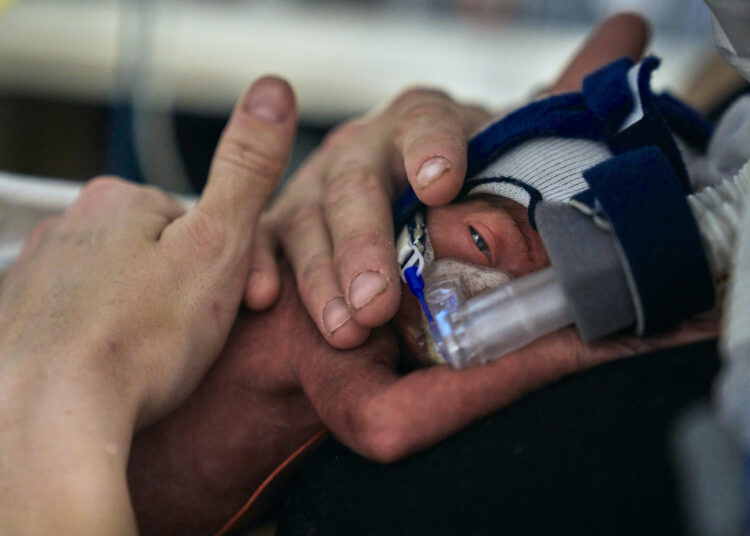When reporter Kavitha Surana and photographer Stacy Kranitz profiled a Tennessee mother forced to endure a life-threatening pregnancy shortly after Roe v. Wade was overturned, they could have let the story end on its bittersweet final sentence:
She whispered a quiet blessing and left Elayna in the pediatric intensive care unit, cocooned under the glow of a warming lamp.
That story, published by ProPublica in March 2023, followed the life of Mayron Michelle Hollis after Tennessee doctors declined to provide an abortion, fearing the implications of the new Dobbs v. Jackson ruling by the U.S. Supreme Court. It stayed with Hollis through the premature birth of a daughter, who weighed under 2 pounds at birth, and her eventual release from the hospital. It ended with the infant back in the hospital with a possible lung infection, and with Hollis struggling to keep a job, stay off drugs, restore a marriage, care for another child at home and pay the bills.
But that’s not where Hollis’ story ended. She now faced a jagged patchwork of resources available — or not — to support an expanded and increasingly fragile family. Surana and Kranitz knew the mother and baby now faced a lifetime of uncertainties as fraught as those that haunted the pregnancy. In light of that, and the continued fallout of the Dobbs ruling, the ProPublica team did did what journalists too seldom do: They kept reporting.
Last month — thanks to support and teamwork at ProPublica, a thoughtful and candid approach from Kranitz and Surana and incredible trust on behalf of Hollis and her husband — published the first story’s searing sequel. “The Year After A Denied Abortion” takes readers into some of the most intimate moments of the Hollises’ lives: unpaid bills, arrests, alcohol and drug relapses, fights, despair. It also reveals two parents who, despite their own trials, are devoted to their daughters, chasing multiple jobs to support them and keep the family together.
Kranitz is a visual freelancer who has made an art of challenging stereotypes, including those of life in Tennessee’s Appalachia region, where she lives. Her images of the Hollis family are deeply personal in ways that might shock some: Hollis sleeping in her car at the hospital, in handcuffs after an arrest, in tears outside of work, in the bathroom as she tries to eat, clean and bathe her child at the same time. In the year-later sequel, images drive a narrative in which photos take the lead; Kranitz, appropriately, gets the lead byline. Text by ProPublica reporter Surana, formerly of the Tampa Bay Times, draws readers along in brief passages of scene and detail based on deep, long-term reporting. The story is told in four chapters and include four drop-in boxes of quick context underscoring the policy, law and budgets specific to Tennessee, which has one of the nation’s most restrictive abortion laws and least supportive family public support systems.
Surana and Kranitz answered questions from Storyboard about how the story was conceived, photographed and reported. They emphasized the importance of close collaboration between photographer and reporter, and between journalists and story subjects.
“Whenever there’s an opportunity, try to involve the person you are reporting on in the reporting process itself,” Surana said. “Once Mayron and (her partner) Chris understood why we were trying to gather documents, they were proactively sending us any letter or bill they received, taking pictures of things going on in their life, and calling to update us regularly. They almost became reporters of their own lives.”
Kranitz said, “During downtime, when Mayron was folding laundry or driving in the car while she was running errands, we would talk about our lives, and I felt it was helpful for her to understand why photography is important to me.”
Our emailed conversation has been lightly edited for length and clarity.
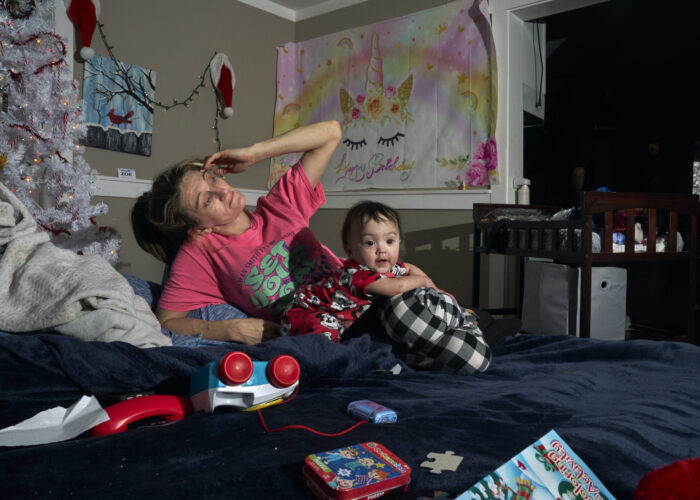
You both worked on a wrenching prior story about Mayron Hollis, who made it through a dangerous pregnancy and the delivery of her daughter, Elayna, in the wake of Tennessee’s strict abortion ban. Not quite a year later, ProPublica published a follow-up that showed how Mayron and her family have fared with few resources in the wake of Elayna’s birth. How did the second story come about, and why did you feel it was important to pursue?
KAVITHA SURANA: After the first story ran, we felt like we weren’t done. We had ended it at a really uncertain moment, when Elayna was back at the hospital on a breathing machine. We actually had to add that to the first story at the last minute because it was happening just days before our deadline. After it published, we heard from so many readers who were desperate to know what would happen to this fragile baby and her family. They were asking me, “Why did you let the story end so abruptly?” But that was the family’s real life.
Led by Andrea Wise, a visual strategy editor at ProPublica, we decided to keep following the Hollises to see how their family would cope during the year. We wanted to examine a core issue: Since Roe v. Wade was overturned, Republican lawmakers who identify as pro-life have banned abortion and celebrated the expectation that more children will be born. But what have they done to ensure those children, who often are born into difficult circumstances, have the best possible futures once they are here? And what does the safety net really look like for the people in precarious situations who are often most affected by abortion bans? To investigate those questions, we knew we would need to dig in for an extended period of time, and this was a rare opportunity to do that in a deeply personal way.
You gained an impressive level of access to Mayron — everything from her medical records to candid conversation with her doctors — in the first story. This one seems to go even deeper and allows you to witness wrenching and intimate moments across a year. How did you manage to maintain that relationship?
KAVITHA SURANA: From Day 1, Mayron made it clear she had a strong desire to share her story and experience with the world. She understood that our role as journalists was to do that. It’s rare to find someone like that. The access and trust, I think, also came from the privilege of having time to be flexible and present and patient. Mayron never sat still. She was so busy trying to get on her feet and deal with new challenges in her life — there was never a moment we could just sit down and talk and get a full picture of what had happened. We met her at the hospital days after the baby’s birth, went home with them when she was discharged, and were nearby to meet Mayron after she first got arrested and the aftermath that followed.
For about three months I basically moved to Tennessee I gathered needed information by being in her presence and slipping in questions over time. Once she knew we weren’t going anywhere and that we were committed to telling the story, she got in the habit of sharing any record she received and any development going on for her and Elayna, so I was informed as things unfolded.
During such a period of turmoil, I think she saw that having people witness and document what was happening could be powerful. It couldn’t solve things, but perhaps it gave a coherence to the challenges she faced because we were invested in understanding the context, asking questions and eventually sharing what we found with the world.
From a practical perspective — geography, communication, the rest of your life — how did you manage spending so much time with Mayron and her family?
KAVITHA SURANA: To get so embedded in one family’s life can be really unpredictable and your own life takes a backseat for a time. We were very fortunate that ProPublica supports that kind of investment, because to capture what is going on you need to be available to spend long stretches of time with someone, to pick up the phone late at night etc.
For the first story, I was the main point of contact and spent most of three months nearby, mainly shadowing her — running errands, hanging around while she prepared dinner or listening to her at 2 a.m. when she had an emergency. Stacy was also there from the beginning and there was so much going on — I kept begging her editor to send her back as much as possible, so she wouldn’t miss anything. We spent the Christmas holiday with the family. One time I slept over with Mayron at the hospital to see for myself what it was like sitting at her daughter’s bedside and helping with feedings into the late hours, then waking up at 4 a.m. to go to a grueling job.
For the second story, the relationship shifted. We had decided to do it as a photo essay. Stacy lives in Tennessee, so she became the main point of contact and began to spend time each month on the ground with the family. I would mostly follow up on the phone, gathering observations and details from both of them and other people in their life.
STACY KRANITZ: As a photographer, I am usually brought in after the story is mostly reported. Being there from the beginning helped me develop a relationship with Mayron and Kavitha simultaneously. During the first few months, Kavitha and I were often together with the family, which allowed us to build a cohesive relationship with her. When we decided to continue the story, I worked more independently with Mayron, spending anywhere between 2 to 10 days a month at her home. This was an unprecedented amount of time for me to photograph a story, and it allowed me to build a consistent relationship with Mayron, her husband, Chris, and their extended family and neighbors. When I was not with Mayron in person, I would check in a couple of times a week to get a sense of her schedule so I could determine what things were happening in her life that were important for me to be there to photograph: doctor visits, court proceedings, birthdays, work and also regular days where nothing, in particular, is planned but life unfolds in unexpected ways.
I was struck by the style of the story, which briefly but thoroughly summarizes developments in the year after Elayna’s birth. There are few quotes, but between the details and intimate photos, you feel as if you’ve spent a year with the family at the center of this story. How did you land on that approach?
KAVITHA SURANA: This took a lot of workshopping and an amazing team of editors. So much happened to this one family over the year that by the end we had an overwhelming amount of material; we really could have written a book. We wrote through drafts that were a bit more traditionally narrative and ended up sprawling all over the place, trying to capture each development and explain its context. We worried it was becoming hard to follow and weighing readers down.
But at its heart, this was always conceived of as a visual-first project. Stacy’s photos are so intimate, so dynamic and so humanizing, that we eventually realized we could strip back the words to serve as an anchor and connective tissue to the storytelling and the policy issues we were interested in pointing out, giving the photos the space to bring you into their world in an even more powerful way.
STACY KRANITZ: This was the first time ProPublica had done this kind of visually driven project. We were in unchartered territory as we tried to develop a relationship between the visuals and the investigative aspects of the story that ProPublica is known for. We experimented with different ways of putting these elements together. Perhaps one of the most remarkable things about working with ProPublica is that they are not afraid to completely abandon a story structure that is not working. We always knew that the design would play an important role. The designers, Anna Donlan and Allen Tan, were brought on early to develop an immersive and interactive style. My editor, Andrea Wise, invited me to be part of internal story development meetings. As a freelancer, this was a unique opportunity to have a say during each stage of the process. During most of my assignment work for publications, I work closely with my visuals editor, but I do not play a role in the development of the story beyond the delivery of images.
Stacy, I was bowled over by the intimacy of the photos you were able to take. You have photos of arguments and heartbreak, but also joy, such as the photo of Mayron crouched with her back to the door, playing with Zooey. How did you interact with Mayron and her family during such powerful moments,? Are there any photos you think particularly tell this story? And Kavitha, did any photos strike you as especially powerful?
STACY KRANITZ: Andrea Wise hired me for this story because she knew I had experience working closely with subjects over long periods of time and do not shy away from complex interpersonal situations. I thought a lot about how a photographic version of investigative journalism might look. The more intimate the photographs, the more likely they would support the rigorous and heartbreaking reporting.
It has always felt disingenuous to not be present with subjects as a dimensional human being. I am asking a lot of Mayron. Spending days and days with her pretending I was not there did not feel like an ideal approach. During downtime, when Mayron was folding laundry or driving in the car while she was running errands, we would talk about our lives, and I felt it was helpful for her to understand why photography is important to me.
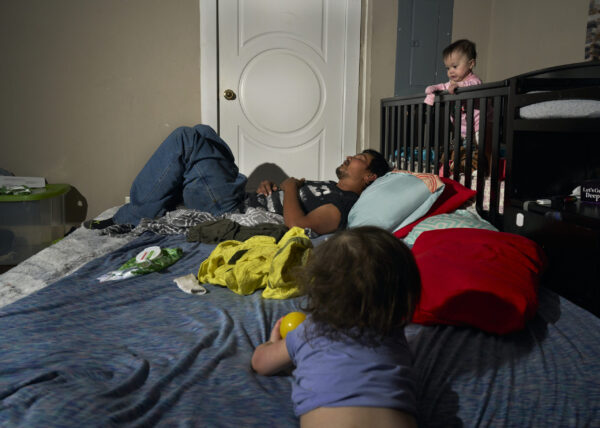
One image that I feel is key to this story is a picture of Chris recovering from a drug relapse in bed. It was Thanksgiving day, and whenever he got up, he felt dizzy and had to lie back down. He spent most of the day in bed, I sat in the room while he slept and made sure to wait until he woke up and knew I was there with my camera before photographing him. I was careful not to be sneaky about the photographs I was taking.
I’m always conscious of subject agency, and while power dynamics are always tricky, I actively work to cultivate relationships where subjects feel they can set boundaries with me. I never approach a situation with the arrogance that I have the right to photograph an intimate moment. Instead, I move slowly into the intimate moments while simultaneously looking for clues that indicate I am crossing a line. At this point, I had spent almost a year with the family and developed enough of a relationship with Chris to believe he knew he could tell me to leave if he was uncomfortable. At first, Zooey and Elayna were taking naps next to him, and when they woke up, I captured this moment where they watched him sleep off the effects of the relapse.
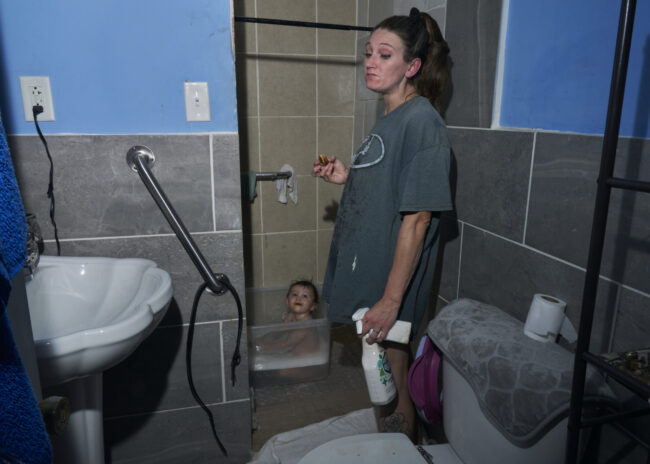
There is one additional image I would like to talk about. It is a photograph of Mayron standing in the bathroom, eating dinner and cleaning the bathroom while her daughter bathes. Motherhood is an intense flurry of multi-tasking, and Mayron excels at this. I spent months trying to get a photograph that showed how she managed to compress numerous actions into a singular moment. The exhaustion on her face, the cleaning solution in one hand and the meal in the other. This image really illustrates Mayron for me.
KAVITHA SURANA: For me, there are so many striking images. There’s the photo Stacy captured of tiny Elayna opening her eyes in her mother’s arms just about a week after birth, which just stops you in your tracks. I find the photos of Mayron taking a break from work about a month after the birth — to call the hospital and record Elayna’s health info — really powerful. In two images you get a clear sense of how physically demanding the job is and of a mother striving against the odds to fit everything into her day and provide what her family needs.
The “safety net” vignette boxes seem especially important; they place the Hollises’ struggles in the larger context of policy, bureaucratic hurdles and the debated meaning of “pro-life.” How was it decided to include these interludes, and how were they researched and written?
KAVITHA SURANA: The team was very clear that the mission of the project was not just to document a portrait of a family’s year, but to do an accountability investigation. (We are ProPublica after all!) It was an intimidating prospect, especially at first. We didn’t know what would unfold in the family’s life, and anytime you put a magnifying glass up to an individual’s experience in this way, you can’t cleanly separate their personal choices from policy. People are human and their stories are rarely clear-cut.
But as the year went on, we noticed and kept track of themes and roadblocks that arose and looked for larger issues to connect them to. The research was supported by our colleague, research reporter Mariam Elba, who helped me narrow down the issues and draw on a wide range of sources to look more closely at Tennessee’s policies. We tried weaving that context into the story itself, but it felt like it was interrupting the story. Once the vignette idea was suggested, I wrote long sections based on the research, but that also felt too long — so we edited them down to be brief interludes. They still interrupted the pure flow of the story, but in a more effective way. One editor said whenever they popped up in the story, it felt like a bracing “slap” that magnified the larger context of their struggles.
You end with a tough sentence to read:
Mayron sat up all night behind bars, on a hard bench, begging for an extra phone call home to wish her daughter a happy birthday.
When — and why — did you realize this was the right ending?
KAVITHA SURANA: There were so many people involved in making editorial decisions and shaping the final story — two visual editors, three text editors, two designers, a research reporter and us. It was a really collaborative process to decide the flow and certain beats the story hit, and the ending was no different.
From the start, we planned to end on Elayna’s birthday, coming full circle on a year in her life. None of us were prepared for what a dramatic day it turned out to be. Once we sat down to review the pictures, it became clear to everyone we had to end with the photo of Elayna with her birthday cake, looking straight at the camera, and really bring it back to the child at the center of this reporting endeavor. It wasn’t until a few weeks later, as we were reviewing the pacing and the flow of the story, that the editor Alexandra Zayas — who has a brilliant instinct for narrative — suggested bringing the viewpoint back for one more beat to Mayron’s perspective. Mayron had driven the story from the beginning, and in the very last scene she was separated from the baby she had been forced to risk her life for.
Is there anything you learned in the course of photographing and reporting this story that will inform your future stories or may be useful to fellow journalists?
KAVITHA SURANA: One suggestion to fellow journalists is that whenever there’s an opportunity, try to involve the person you are reporting on in the reporting process itself. Once Mayron and Chris understood why we were trying to gather documents, they were proactively sending us any letter or bill they received, taking pictures of things going on in their life, and calling to update us regularly. They almost became reporters of their own lives.
I would also remind text reporters to invest in developing relationships with photographers and invite them to be partners in the reporting whenever possible. That was already extremely valuable in how we approached the first story, not only to get the kinds of photos that move readers, but also to have a second set of eyes observing and gathering information in different contexts. It helped both of us to be able to compare notes throughout.
With the second story, it was fascinating to see how things evolved with an editor from a different discipline taking the helm and directing things. The opportunity to work on a visual-first project is a rare one. I learned a lot by taking a backseat and watching how Stacy and the visual and design editors approached the work; I tried as much as possible to be a support to the vision that they had, in kind of a flip from the usual process where a photographer comes in to support a text reporter’s vision. I would suggest more newsrooms try an approach where they let the visual and reporting elements hold equal weight throughout the process. We heard from so many readers who felt the depth and intimacy the photos brought were key. Some said that if they had just read the story, they might have judged the family differently, but seeing the photos was intensely humanizing.
STACY KRANITZ: The process of sending in a photographer towards the end of a story is outmoded. I’m lucky to get more than three days to visualize a reporter’s carefully constructed words; often the shallowness of the images does not serve the story or the audience.
There is something special about allowing the photographs and text to develop together. It was a gamble for ProPublica to do this, and I think the response we received demonstrates an appetite for visually invested reporting. We are in a dying industry and this has made us less willing to take risks with how we report stories. I hope the success of this story leads other editors to believe in trying new ways of combining images and text to draw the reader in.
What kind of reaction have you had from readers?
KAVITHA SURANA: The reaction has been really overwhelming. The story on Instagram got the most likes and re-shares of any story ever posted on ProPublica’s account, and the comments showed us that the story — both its presentation and the themes that it touched — struck a nerve. It inspired a lot of discussions in the comments. Many readers wrote that they had cried, but it also made them outraged. Some said it connected with challenges they faced in their own lives; others said they hadn’t been able to stop thinking about the family since they read the story. Many people also donated to the Hollis family and wrote them encouraging messages of hope.
STACY KRANITZ: The reaction to this story moved me. So often, you work on a large project like this, publish it, and the next day it feels like it barely registered in the larger news cycle. The day before this story was published my editor and I spoke about how it can be depressing to see a project you work so hard on dissipate into the ether so quickly; she reminded me to brace myself for that. Both of us were truly surprised when feedback about the story continued for weeks from both readers and colleagues.
ANDREA WISE (visuals editor): Senior editor Ziva Branstetter, my partner editor on this project, said from the beginning that we should trust our readers, but I will be honest that I was a bit more skeptical. I couldn’t sleep the night before the story published. Abortion is such a divisive and emotionally charged issue for so many, and people (especially on social media) can be quick to judge. To my surprise, Ziva was right. Of course there will always be a range of responses to a story like this but the reaction was overwhelmingly positive. From the comments on social media, we could see that a lot of people related to this family’s struggles. Readers saw how much Mayron and Chris loved their children, how hard they were fighting to build a better life for their family, and how little support the state provided them to care for this baby after denying them an abortion for such a high risk pregnancy. This experience has really taught me that we can tell complicated stories about complicated people facing complicated challenges and, if we do our jobs right, we can trust our readers to get it.
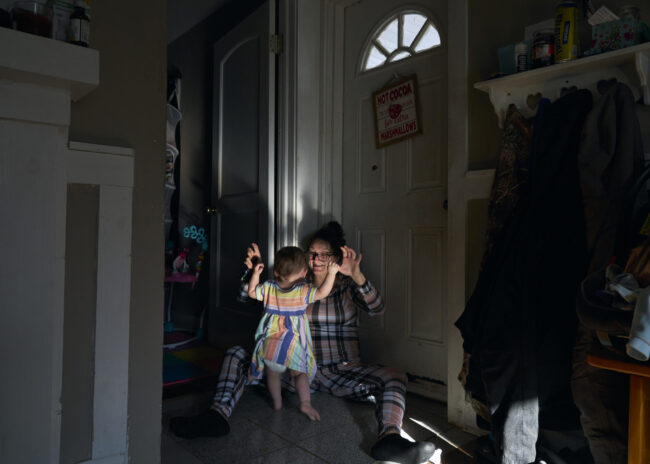
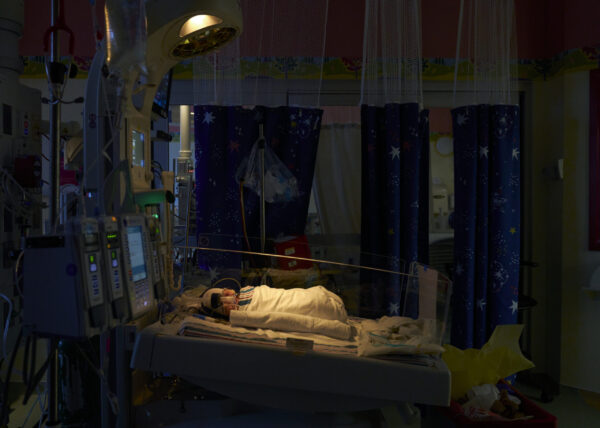
* * *
Trevor Pyle was a newspaper reporter in the Pacific Northwest for several years, and is a communications officer for a regional nonprofit.
